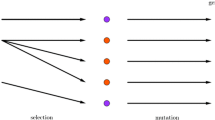Abstract
The concept of natural selection is examined, which is one of basic principles for the Darwinian interpretation of evolution. In this model selection is defined as a solution of the deterministic Eigen equation. Next, the random effect is introduced through the mutation term. However, the probability of finding the solution expressing the selection is shown to be smallest. The validity of the model and its applicability to polynucleotide replication are discussed.
Similar content being viewed by others
Literature
Eigen, M. 1971. “Self-organization of Matter and the Evolution of Biological Macromolecules.”Naturwiss.,58, 465–523.
Eigen, M. and P. Schuster. 1977. “A Principle of Natural Self-organization. Part A: Emergence of the Hypercycle.”Naturwiss.,64, 541–565.
Schuster, P. 1978a. “Part B: The Abstract Hypercycle.”Naturwiss.,65, 7–41.
Schuster, P. 1978b. “Part C: The Realistic Hypercycle.”Naturwiss.,65, 341–369.
Feynman, R. P. and A. R. Hibbs. 1965.Quantum Mechanics and Path Integrals. New York: McGraw-Hill.
Gel'fand, I. M. and A. M. Yanglom. 1960. “Integration in Functional Spaces and its Applications in Quantum Physics.”J. Math. Phys.,1, 48–69.
Goel, N. A. and N. R. Dyn. 1974.Stochastic Model in Biology. New York: Academic Press.
Haken, H. 1976. “Generalized Onsager-Machlup Function and Classes of Path Integral Solutions of the Fokker-Planck Equation and the Master Equation.”Z. Physik.,B24, 321–326.
Inagaki, H. 1977a. “Zero Modes of Quantum Fluctuations for the Instanton.”Phys. Lett.,71B, 403–406.
Inagaki, H. 1977b. “Quantization of Scalar-Spinor Instanton.”Nuovo Cimento,42A, 471–485.
Jones, B. L., R. H. Enns and S. S. Rangnekar. 1976. “On the Theory of Selection of Coupled Macromolecular Systems.”Bull. Math. Biol.,38, 15–28.
Küppers, B. 1979. “Towards an Experimental Analysis of Molecular Self-organization and Precellular Darwinian Evolution.”Naturwiss.,66, 228–243.
May, R. M. 1973.Stability and Complexity in Model Ecosystems. Princeton, N.J.: Princeton Univ. Press.
Mortensen, R. E. 1969. “Mathematical Problems of Modeling Stochastic Nonlinear Dynamic Systems.”J. Statist. Phys.,1, 271–296.
Thompson, C. J. and J. L. McBride. 1974. “Eigen's Theory of the Self-organization of Matter and the Evolution of Biological Macromolecule.”Math. Biosci.,21, 127–142.
Turelli, M. 1978. “A Reexamination of Stability in Randomly Varying versus Deterministic Environments with Comments on the Stochastic Theory of Limiting Similarity.”Theor. Pop. Biol.,13, 244–267.
Wigner, E. P. 1967.Synmetries and Reflections. Bloomington: Indiana Univ. Press.
Author information
Authors and Affiliations
Rights and permissions
About this article
Cite this article
Inagaki, H. Selection under random mutations in stochastic eigen model. Bltn Mathcal Biology 44, 17–28 (1982). https://doi.org/10.1007/BF02459416
Received:
Revised:
Issue Date:
DOI: https://doi.org/10.1007/BF02459416




